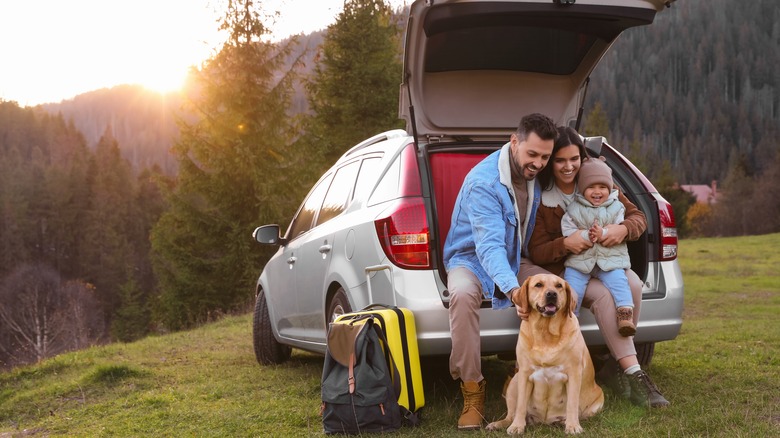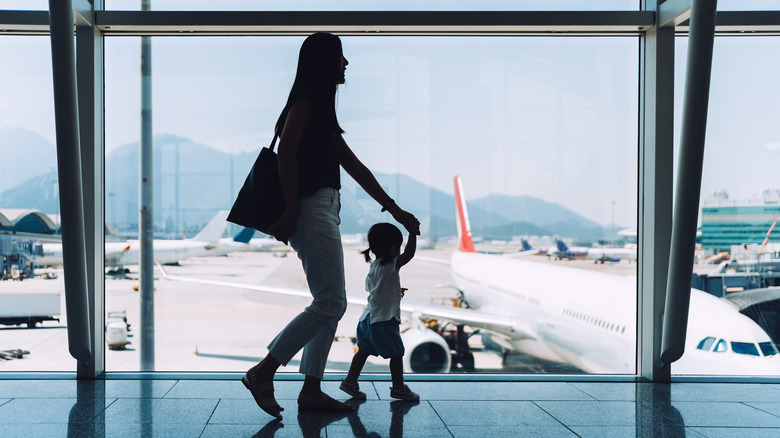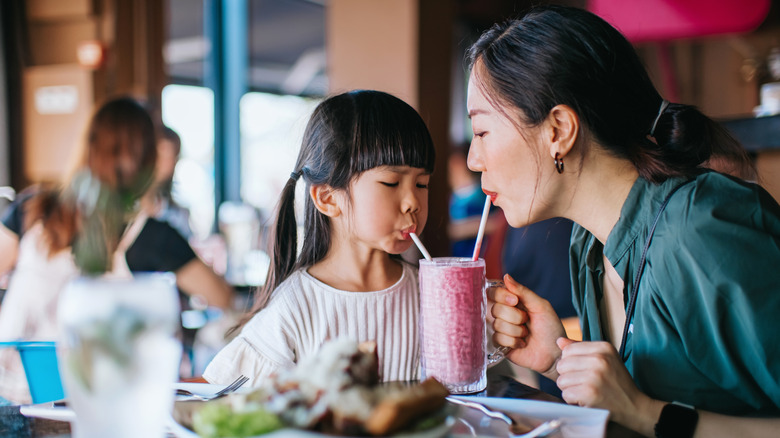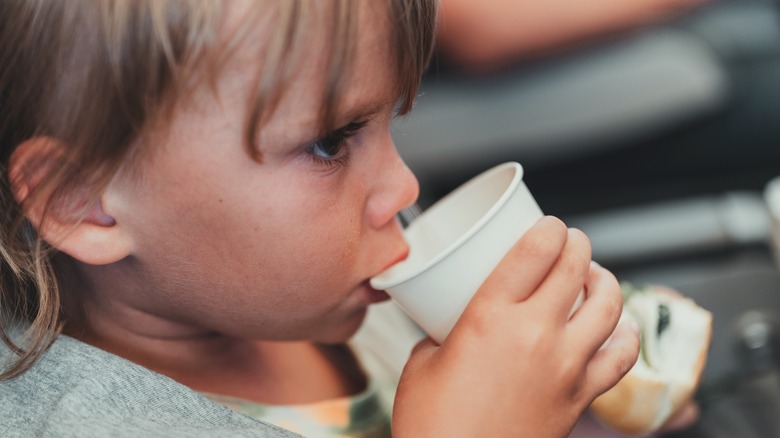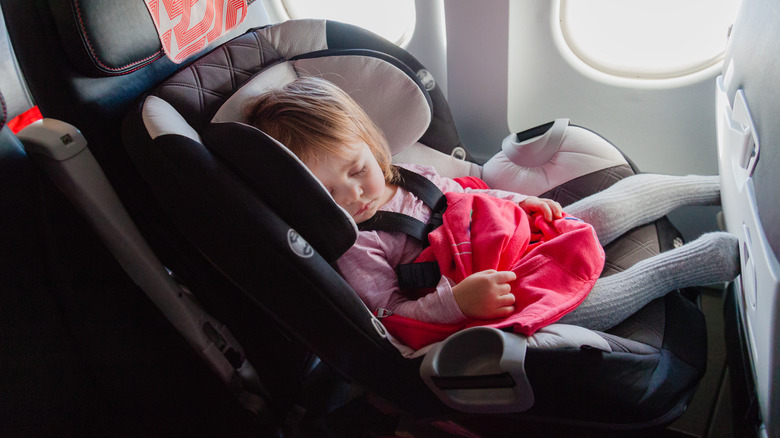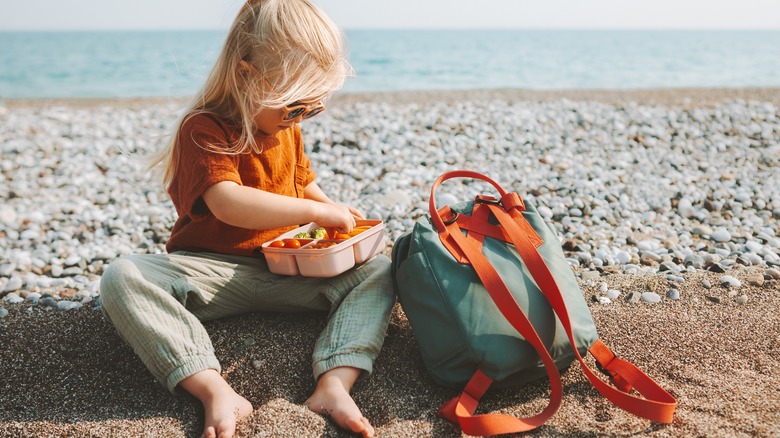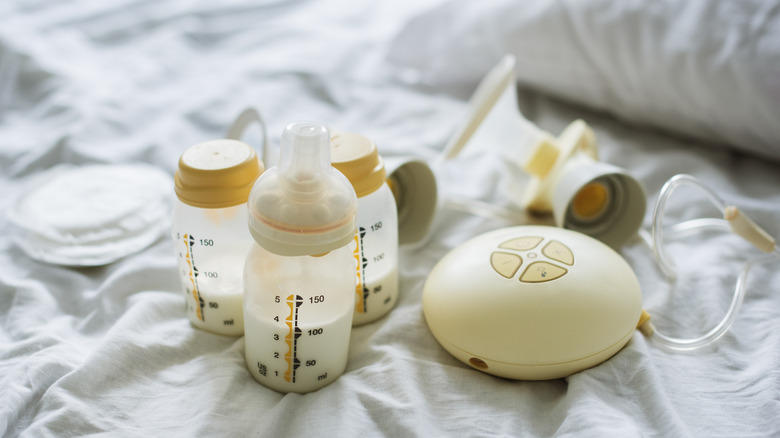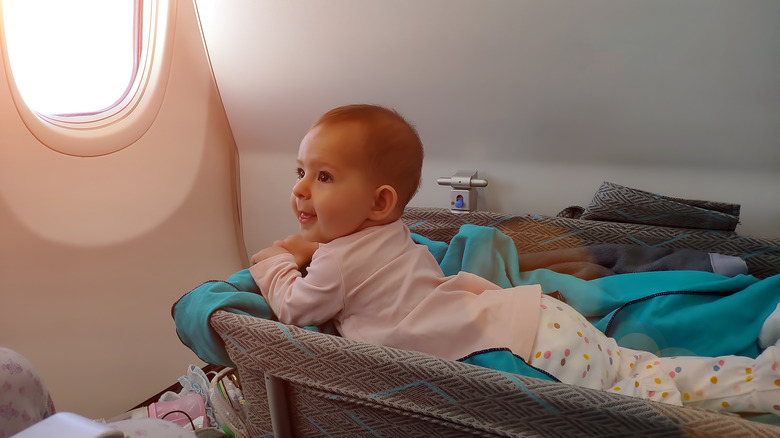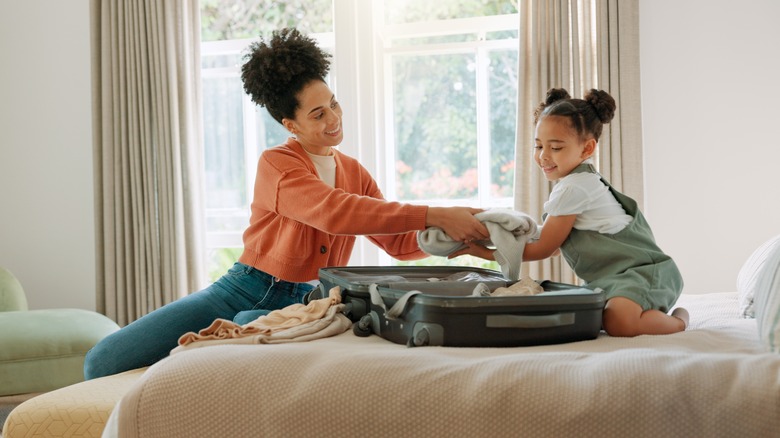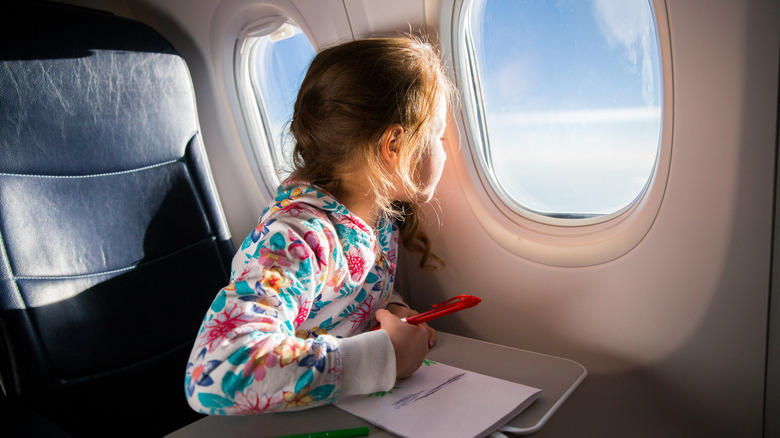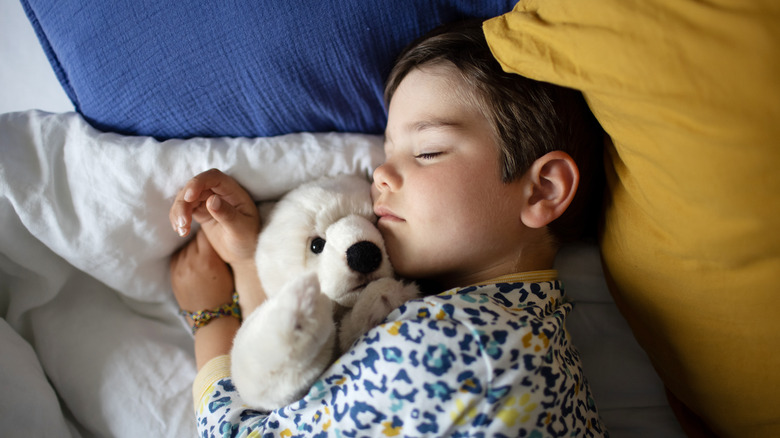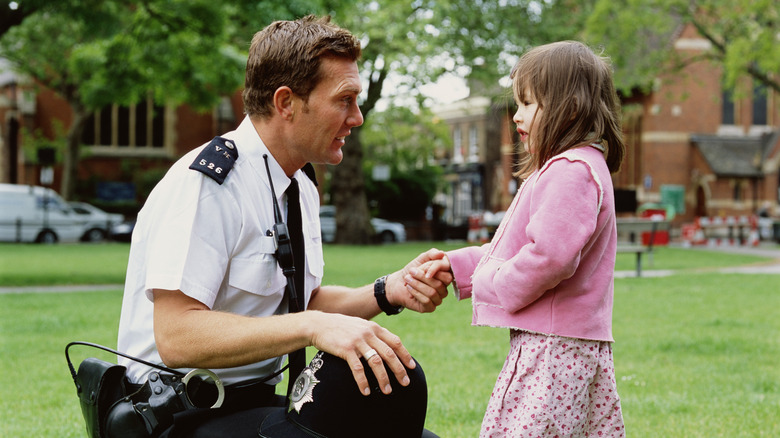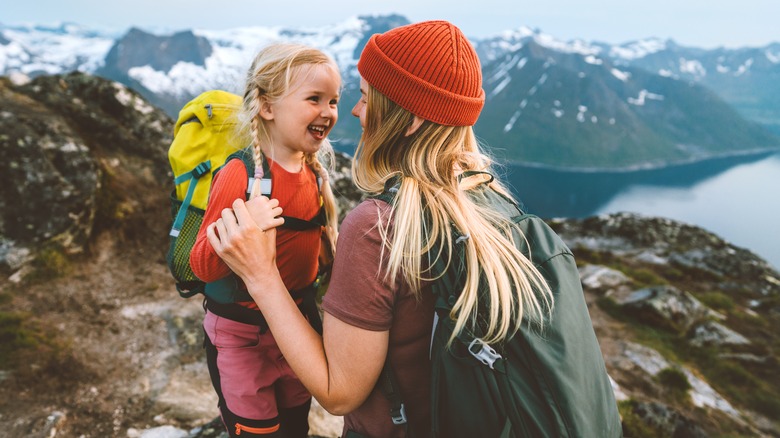The Easiest Tips And Tricks For Making Traveling With Your Kids A More Stress-Free Experience
It is no secret that traveling with kids can be a magical experience. Indeed, it is a blessing to observe the wonder in a child's eyes as they buckle into their first pair of skis, taste a foreign fruit, or realize that monkeys exist outside of picture books. Despite the myriad joys that are part and parcel of family vacations, it is also no secret that traveling with kids can be stressful.
Attempting to keep everyone happy when each family member has their own desires and needs can be tough. Every decision you make, from where to sit on the plane to the rental car you choose to book, is laden with consequences. That's why we have put together this guide of the easiest tips and tricks to make traveling with your kids a more stress-free experience. No matter where you are headed, we hope everyone in your family gets the vacation they deserve!
Board first with a baby but last with toddlers
The best time to board the plane when you're flying with kids depends on the situation. On most airlines, infants under two can sit in your lap for free. Getting to your seat with a baby, however, can prove challenging, and you may require special assistance. After all, you might be toting a baby, a stroller, a diaper bag, a personal item, and a carry-on suitcase simultaneously. If you are traveling alone with a baby, don't wait until you board to request help. Instead, ask for assistance at the gate; airline personnel will often carry bags to your seat for you and then hold your child while you get seated (if you are comfortable with that).
On the other hand, if you've ever gone anywhere with a toddler, then you know it is vital to keep them entertained, lest your outing turns into a meltdown. On a plane, and especially on long flights when they have no choice but to sit, it is naturally difficult for toddlers and young children to occupy themselves. Let them expend as much energy as possible before boarding; for instance, by playing "I Spy," riding trams, and looking at the art installations many airports feature.
Look at menus in advance
For many people, dining out and trying new cuisines is one of the most pleasurable aspects of travel. However, it's not uncommon for a child to demand the same meal, such as mac n' cheese, every night. Look at menus ahead of time to determine which restaurants are suitable for you and your kid. A Michelin-star restaurant may appeal to you, but not your child. Conversely, your child may want to eat at a familiar restaurant chain, but you might want to try something new. Both of you are on vacation and deserve a treat, so try to find common ground.
In an interview with Mary Squillace on Medium, Dr. Natalie Muth, MD, RD, pediatrician, and registered dietitian, recommends letting children choose their meals. Muth also recommends "bridging" foods, which means introducing new foods that are similar in texture or taste to dishes your child already likes. For instance, present scrambled tofu instead of scrambled eggs. Similarly, Muth says, you can pair new foods with already beloved ones. This might look like ordering a deconstructed poke bowl that allows but does not force your child to experiment with new flavors. Finally, know everyone's orders before entering the restaurant. Ordering straight away will reduce wait time, which could otherwise make kids impatient.
Feed children at takeoff and landing
When your head is in the clouds, your ears are bound to pop. That's because air pressure decreases as elevation increases. Airplane cabins are pressurized so that as a plane rises, the air pressure inside automatically adjusts to mirror that which is outside. However, a small amount of air remains trapped in our ears. This air has a higher pressure compared to the air that is in the cabin, and as a result, it exerts force on your eardrum. Your body's solution is to let air pass through the Eustachian tubes and thereby equalize the pressure. The same is true in reverse when a plane descends.
We help our ears equalize through such acts as yawning and sipping water. Children, however, tend to have more difficulty equalizing because their Eustachian tubes are narrower. To help your kids have a more comfortable ascent and descent, have them sip fluids upon takeoff and landing. You might also give them a stick of gum, a lollipop, or snacks like grapes to encourage saliva production and frequent swallowing. If traveling with a baby, nurse or bottle feed them.
Consider different car seat options
The Consumer Reports and the American Academy of Pediatrics (AAP) recommends that children use size-appropriate car seats until they are at least 4 feet 9 inches tall. This milestone typically occurs between the ages of 8 and 12. Luckily, you have many options when it comes to traveling with a car seat.
One option is to check in your child's car seat for free, which most airlines allow. Buy a car seat bag ahead of time, and be respectful regarding your airline's baggage policies; while it can be tempting to stuff car seat bags with lightweight items like diapers, this is generally not allowed. Another option is to bring the car seat on the plane, although you will need to first check whether your airline has approved it for in-flight use. While infants under two years old can fly in your lap for free, reserving a spot where you can install their car seat can prove more comfortable for you both (though not necessarily budget-friendly).
Finally, you can rent a car that comes with a car seat already assembled, removing the hassle of lugging it through the airport and securing it in an unfamiliar vehicle. However, your child may not be comfortable in the seat provided, and it does typically come at an extra cost. Unless you are traveling by public transportation, you will need to have someone with a car seat pick you up and drop you off.
Pack snacks
Airplane food is not known for being the most appetizing, readily available, or sensitive to dietary needs, and how they make their way to your tray table is why Gordon Ramsay won't eat airplane food. Roadside convenience stores aren't much better, frequently offering food with low nutritional values and high price tags. As for the grocery stores at your destination, they may not carry the fruits, vegetables, and shelf-stable goods you're used to back home.
Familiar foods are a must for children, so pack what they are accustomed to eating. Take more than you think you'll need because your kid might end up eating snacks for dinner one night if no other suitable options are available. Favor shelf-stable snacks like trail mix, fruit jerky, granola, and cheese and crackers (hard cheeses can safely travel unrefrigerated). For shorter journeys, invest in reusable single-serving pouches to store foods like yogurt and applesauce.
Don't forget to feed yourself, too. A hangry caretaker is more likely to make mistakes, not to mention put a damper on everyone's mood. Don't rely on sharing snacks with your kids, who may demand for more than usual in times of boredom. Besides having your own special stash, foods like dark chocolate and spicy nuts can keep you satiated and comfortable.
Have a game plan for nursing or pumping
If you are breastfeeding, know when, where, and how you want to express milk. If you haven't already, you might want to purchase a breast pump that is rechargeable or comes with a battery pack. Using this pump in conjunction with a hands-free nursing bra can make expressing milk in public a much smoother, more private act. Hand pumps can be better, however, if you express milk less frequently. Bring along a cooler bag with ice packs to store your milk.
If you are flying, operate on the assumption that baggage and security lines will be long and that it, therefore, might be best to keep a bottle of milk ready. You can bring this milk, as well as drinks and food for babies and toddlers, through security; it does not even need to be frozen. If you plan to pump or nurse on the plane, it's bad form to do so in the lavatory, which is often in high demand. Instead, try getting a whole airplane row to yourself with this seating trick. If on a long-haul flight, reserving a seat on a bulkhead allows you to sit on the floor and nurse when the seatbelt sign is off. Using a baby sling is also fantastic — the fabric can cover your child and breast.
Reserve a bassinet seat
If you are traveling with a small infant on a long-haul flight, consider reserving a bassinet seat. While it does come with a small price tag, it can be a huge relief for your arms to let go of your little one from time to time. Additionally, your baby may sleep better when horizontal, and you might sneak in a few Zs yourself since you won't be worried about dropping them. Because bassinet seats are typically on bulkheads, you'll even get to stretch out your legs. Note that you will need to hold your baby at takeoff and landing, as well as during turbulence.
Sound luxurious? First check the size restrictions on your airline; typically, bassinets can comfortably accommodate babies until they are about one year old, with 18 months being the rough upper limit. If you determine that your baby will be the right size on the date of travel, make your reservation well in advance; these seats can be booked by passengers without babies, too.
Organize clothing and pack extra
Do a little research, and you'll find that there are countless methods to help you better organize your family's clothes while packing for vacation. You can stuff shoes with multiple pairs of socks, follow a clothes-rolling method to save space in your suitcase while packing, sort clothing into resealable plastic bags, invest in a compartmentalized suitcase, use compression bags to save space, and-or use a pair of packing cubes to keep each family member's clothing separate from one another. There are plenty of opinions about which method is best; experiment and see what works for you.
Additionally, messes are inevitable when traveling with children — this is due to factors like spit-up, drink spills during turbulence, and tantrums involving the throwing of unfamiliar foods. Therefore, a good rule of thumb is to pack a few extra outfits both for yourself and your children. This holds true whether you are planning a simple day trip or an extended vacation.
Bring entertainment
Once you pull out of the driveway or after your plane hits the runway, your children will be doing one of the activities they hate the most: sitting. Nevertheless, the best way to keep kids well-behaved during a flight, according to a flight attendant, is to keep them entertained in their seats. That's why you should pack several sources of entertainment. Of course, if you are flying, make sure every item meets TSA regulations.
Some must-have items for babies include stuffed toys, rattles, teethers, nesting cups, and picture books. Toddlers are likely to enjoy painter's tape, dot sticker kits, picture books, and coloring books. Older children can occupy themselves with journaling and activity books, as well as by listening to podcasts specifically designed for children. Regardless of your child's age, it is best to select items large enough not to get sucked into the black holes that are seat gaps. Verbal activities, like road trip games, can be a great alternative to solitary play that requires no equipment.
Allot for decompression time
Whether you are packed into a car like sardines or sharing a small hotel room, you'll find yourself in close quarters with your kids for long stretches of time while on vacation. After patiently responding to tantrums and questions and after cleaning up more than one mess, you'll want some time to yourself — and if your kids are tweens or teens, they'll want some time to themselves as well.
To keep everyone's spirits and stamina high, allot time for family members to relax, reflect, and regroup after flights, drives, and stimulating activities. Ultimately, a family vacation is an equation where the needs of the individuals and the group must all be met; decompression time helps keep that equation in balance. Following time alone to process, family members can come back together with more energy and clarity of thought. Decompression time is especially important when dealing with jetlag because not everyone will recover in the same way. Additionally, buffers help prevent unexpected delays, such as long Uber wait times or room lock-outs, from derailing your entire itinerary.
Plan mini-dates
If you are traveling with a romantic partner, selecting a family-friendly resort or bringing along nanny can make finding romantic time easier. However, these amenities are by no means necessary. Looking forward to mini-dates instead of full-blown romantic dinners can relieve the pressure of finding childcare for an hour or more. It's best to brainstorm ideas beforehand, lest you get caught up in the chaos of traveling with kids and forget to make time for your boo.
Mini-dates don't need to be complicated. In fact, you don't even need to go anywhere. Mini-dates can take place while children enjoy independent play or while they are asleep. Simply devote a few minutes to your partner, free of distractions, and make sure your conversation does not revert to logistical planning and child-related subjects. Instead, cultivate compassion and romance by discussing your emotions and what you are grateful for about each other.
You don't even have to talk; if your children are running ahead on a stroll through the park, you can simply hold hands and enjoy one another's presence. Other mini-date ideas include savoring a breakfast of coffee and local pastries while the kids are asleep, reading to one another in bed, or dancing together anytime and anywhere.
Teach your children safety tips
Unfamiliar places pose dangers that your child may not immediately perceive. Prepare your kid in advance by familiarizing them with safety guidelines and what to be wary of when you reach your destination. For example, if you are traveling to a city, make sure they know how to keep valuable items safe from pickpockets and that they should always walk in front of you. If you are traveling internationally, teach everyone the country's emergency number and medical hotline.
Despite precautions, it is not uncommon for children to become separated from their parents while traveling. Decide on a code word before leaving so that if you and your child are separated and a third party needs to form a liaison between you, your child knows whom they can trust. Quiz your child frequently about this code word. Also, point out people they can approach for help, such as park officials and law enforcement staff, and identify a meeting place, such as the resort pool, where you can convene if needed. Finally, do your own research ahead of time to ensure you are cultivating a safe environment for your family. For instance, learn a travel safety expert's best tips to feel as secure as possible during your hotel stay.
Give everyone a role
When even a simple outing to the pool can feel like a mammoth task, you can easily feel overwhelmed by all the planning needed to pull off a family vacation. To save yourself immense amounts of time and stress, delegate. Doing so is not only good for you, but it's good for your child, too. Providing your kid a sense of agency will help them feel more secure in unfamiliar surroundings, as well as hone valuable life skills like research, communication, and forward thinking. It will also cultivate a sense of trust between you that flows both ways. Plus, you are less likely to hear complaints if each person is granted decision-making power.
Giving everyone a role in the family vacation will look different, depending on the age of your children. Perhaps each family member gets to plan the activities for one day of the trip. Or maybe one person is responsible for choosing hotels, another for researching transportation options, and another for selecting restaurants. You can assign younger kids more fun and educational tasks, such as preparing notes on a monument's significance or choosing three road trip games for the day.
Plan an active, outdoor vacation
Hikes, swims, and bike rides will "tire out your kid," but more importantly, these activities will allow them to enjoy their travels, balancing out more cerebral museum visits and long periods of sitting. There's another, less obvious reason to include outdoor activities in your itinerary, though: They will help your child better remember their vacation and the precious time you spent together.
For the most memorable vacation possible, select activities that engage all five senses: touch, smell, taste, sound, and sight. Andrew Budson, M.D. and Professor of Neurology at the Boston University Chobanian & Avedisian School of Medicine, explained in an interview with Harvard Medicine Magazine that "Anytime you are forming memories that you want to stay with you, you want them to be as multisensory as possible." That's because the brain builds bridges between sensory inputs so that when, for example, you smell a flower that was blooming on your last hike, you might recollect how you helped your child cross a stream.
Because nature is so rich and dynamic, it is guaranteed that most outdoor activities will engage all five senses. To maximize time in nature, camp instead of staying at a hotel. Your children will be able to play more active and imaginative games, and you will save money, introduce your kids to new experiences, and give everyone a much-needed breath of fresh air.
